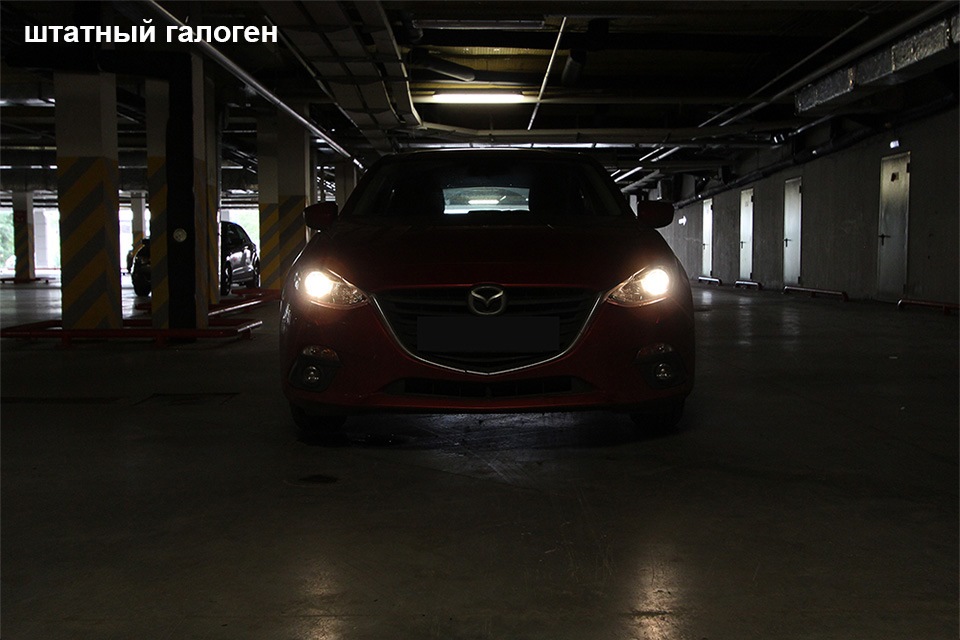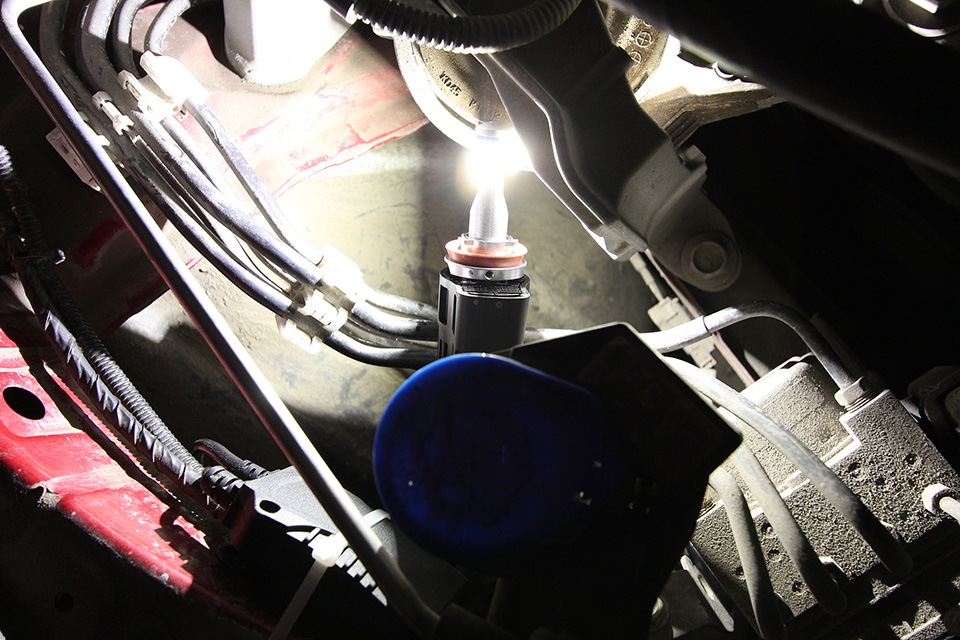Hello everyone)
I'll tell you today about LED low beam bulbs. The idea of installing these bulbs arose a long time ago and then a case came that one lamp in the near one burned out, and, accordingly, I decided to find worthy alternative them. Traveled around the markets, looked at what's what and for what. When choosing lamps for me, the main criterion was that it fit into the headlight and the lid closed, and, of course, that it somehow corresponded to the cut-off limits. But I did not find such lamps on the market) They were all with blocks, a bunch of extra wires that I did not need at all. Well, then I climbed onto everyone's beloved Aliexpress, I found worthy light bulbs from reviews for so little amount of 1,700 rubles) On YouTube there is a review of the same bulbs, only with a different name, well, I think, but let me try it too) Especially at work , colleagues have long been driving with similar bulbs in the near (since the first diodes went), they really like them, admired, recommended.
I made an order, after a little less than a month they came to me) Here it is a long-awaited box)
Here is a diode light bulb with a conventional one in comparison
There were no problems during installation, diode bulb entered the headlight as a cast))
Even the lid closed, but with a slight nuance. If you leave it as it is, then the upper part of the diode cooler touches the cover and because of this the headlights shine lower than expected. I found a way out for myself) I took the lid, an engraver grinded all the insides of the lid, which clung to the radiator, and it turned out something like this.
But now nothing catches on and the lid closes calm and the headlights shine as it should)
Well now general form how it looks from the outside. The light of the diodes is crystal white with a slight cold tint.
Well, now the most interesting thing is how they shine in business. I made a small photo report, in approximately the same conditions and in different weather conditions. I made a report on the low beam, I didn’t do the distant one, I don’t use it especially)) And I just forgot about it)
This is how ordinary halogens shine
The left headlight has a halogen in the right diode. It can be seen that there is a check mark, but they shine many times brighter
Right now, many will begin to say that all this is bullshit, there are no boundaries, they blind and other nonsense.
I specially drove to work, took an adjusting device and checked how they shine without adjustments, stupidly changing the light bulb from a conventional to a diode
STG is almost normal, there is a slight flare, which is corrected by small headlight adjustments
Well, now a photo of how they shine in various road conditions.
My favorite thing when I changed the bulbs for many is to take a picture of how they shine on snow or dry asphalt))
Well, I was no exception)) They shine on the snow really decently, very brightly and well, just like on dry asphalt)
Now how the neighbor shines on the dirty asphalt
Middle + tumanki
Well, one photo in motion from the phone on the dirty asphalt
Well, on the wet asphalt, how the neighbor shines
Middle with tumanki
Well, I'll tell you a little about my personal impressions. I have been using them for the third month already. I honestly expected much less from bulbs for such an amount than they actually can) Before that, there were Osram CBH 5500k, and so in comparison with them they shine much better, the road really became better visible in any weather conditions, In dry or snowy weather it became it's a pleasure to drive, in rainy weather the visibility has increased surprisingly, I don't know how to explain it, but the halogen light in such conditions was lost on the road, and the diodes per revolution became better visible) plus they do not heat the headlight and do not need to be washed as often as with halogen)
But these are purely my impressions and sensations, so I don't want to impose anything on anyone, but they really shine better than a halogen.
As for the legality of this installation, I'm not sure, everyone's opinions differ, but it cannot be called illegal either, nothing is said about diodes in the SDA, especially for diodes they have not yet made GOST)
In fact, this violation is qualified by article 12.5 part 1. The list of faults in which the operation of the vehicle is prohibited (the lamp does not correspond to the type of headlight or reflector, entails a warning or a fine of 500 rubles) and not article 12.5 part 3 as special signals.
But there is already someone you run into.
An LED can be considered an inexpensive and durable light source. For a long time, the use of LEDs in the automotive industry was limited: such a source could not produce enough lumens, although it consumed little energy. With the advent of bright and superbright semiconductor emitters, the situation has changed. Now many firms, mainly from China, seek to produce kits that allow replacement standard lamp for a LED lamp (an array of light diodes). Let's try to compare the efficiency of the near illumination obtained from the standard halogen lamp and from diode assemblies. All experiments will be carried out on a real-life car, trying to illuminate a pedestrian wearing a standard reflective vest.
Test results are disappointing
You can completely get rid of incandescent lamps in a car, moreover, we are not even talking about using "xenon". Source high beam may well be a laser that illuminates a fluorescent screen. The rest of the lamps should then be replaced with LEDs, and what will come of this, we will consider further.
For all their arrogance, the manufacturers of LED optics of the NONAME brand are well aware that no one will use their lamps as a source of high beam. Daytime running optics, "foglights" and, perhaps, low beam - these are the main areas of application of LED technology today. But it seems that the LED optics bought in the store do not always reach the standard "halogen" in terms of efficiency. You can see for yourself.
It is easy to see that at a distance of 10-15 m, LED technology provides near-perfect visibility. The beam emanating from the "halogen" looks narrower, and the spot from the LED lamps is located closer to the car. But as a result, at a distance of 20 m when using LEDs, only reflective details can be distinguished, which will slightly stand out against the general background. But for "halogens" 20 meters is far from the limit. From a distance exceeding 20-30 m, a reflective vest becomes indistinguishable at all, if we talk about LED optics. We do not exclude that best performance may have branded LED headlights designed by the car manufacturer. But so far, such decisions can only be observed in concepts and in supercars.
We are looking for an error in our research
By being connected to a voltage source, by themselves light diode lamps shine mercilessly - just blinds the eyes. But the quality of the headlamp glow also depends on how accurately the entire optical system will be tuned: lamp, reflector, lens or diffuser. Changing the settings of the course optics in which the diode assemblies are installed, it is not particularly possible to move the light spot forward. It looks like the LED lamp needs a special reflector and diffuser designed "for it".
Nowadays, LED lamps are common, consisting of two diodes, which are installed on different sides one plane. In shape, such a lamp resembles the "halogens" used regularly. Note that just such lamps were used in the experiment. Only now, the external similarity and increased brightness- it seems that not all the factors providing good illumination... Radiation in a halogen lamp comes from a filament, but here we have a plane. Whoever wants, let him design a reflector, for us the conclusion is obvious: it is strictly forbidden to simply change the "halogen" for a source of another type.
- The shade of a broken headlight will take a long time to pick up, and the LED optics themselves are rather unreliable;
- You need to prepare for a phenomenal replacement at the expiration of the factory warranty;
- LED assemblies get hot and dirty, in general, everything is like with the worst "halogens" in the 90s!
Maybe, knowing about the listed factors, professional tuning studios are in no hurry to switch to the use of LEDs (at least until recently, this was the case). The optics developed by the car manufacturer need no improvement. That is, it is hardly possible to significantly improve it in principle (and even more so, simply by changing the lamps).
We got a kind of pessimistic review ... In fact, all of the above did not appear here to dissuade someone from making a long-awaited purchase. The main thing is to know what to buy and from whom, as well as why exactly all this is needed.
In general, the 4th test was supposed to be about lamps with a flexible radiator (called G5), but the lamps are rather dull and are not suitable for low beam. And I just got a request to write about others, so first I write about the h11 LED lamps called P6.
They are available in two versions: there is 45W with the trendy mini LUXEON Z ES LEDs, and there are more powerful 55W with the already proven LUXEON MZ LEDs. I had more powerful ones, but I think I will be able to test others later.
1. Appearance like this:
The box contains 2 lamps, 2 drivers, instructions in the style of "take out the old lamp and insert a new one" and a hexagon to adjust the focal length. The drivers are not heavy, neither are the lamps. Everything is neat and trustworthy.

The driver is connected with the same connectors as for the previous lamps, then the cap is screwed on top and a waterproof connection is obtained.

The adapter base can be removed and replaced with another. You can fix the plinth at the beginning of the thread, you can screw it all the way. In this case, the LEDs will be either closer to the front edge of the headlight, or further away from it. The difference in the position of the LEDs is about 5 mm. I think this should noticeably affect the focusing of the lamp and STG.
I didn’t experiment, because it’s uncomfortable and dirty to do it in the parking lot of the shopping center. I just fixed the base by eye at the same distance to the LEDs as the halogen had to the filament. But I think those who wish can get confused and somehow adjust the light to their needs (raise it higher, for example).
The lamps have a fan. It is not very loud, but also not as quiet as the T3 lamps. I put the blocks under the hood in the first available place, pulled them onto the clamps. I think you can find a place farther away, out of sight, but I don't need it.
2. The LED type declared by the manufacturer is Lumileds Luxeon MZ. There are 4 of these LEDs on each lamp. The LEDs are located along the side of the lamp, rather than across, like the LMZ lamp from the second test. Apparently the Chinese realized that the incandescent spiral of the halogen is not stretched across the lamp, but along, and it is logical to place the LEDs as well :) It is strange that they did not immediately understand this and riveted lamps with horizontal LEDs or triangular or squares for a long time.

The declared luminous flux is 5200 lm. This is more than 3 times more than that of a halogen. Xenon is also resting. Judging by the specification, LEDs of this type can in principle produce up to 1290 lumens. That is, in my opinion, at the maximum current recommended by the manufacturer, the lamp can give out 1290 * 4 = 5160 lm. The Chinese rounded up a little :) Maybe the lamp doesn't have 5200 Lm, but the flux of 4000-4500 Lm from one lamp is quite real. For low or high beam, this is more than enough. In fact, the lamp is really very bright.

3. The lamp power declared by the manufacturer is 55 watts. The same as for a standard halogen ... That is, you can forget about energy saving. But again, cars will not have problems with checking lamps, since there is only one power, then probably the on-board computer will not swear at such lamps. And I have no checks on the Mazda, which I am very happy about! I will write the exact power of the lamp a little later, I forgot to measure the current ...
4. I measure the brightness at a distance of 1 meter. On the luxometer, the numbers float up and down in the range of 16000-17000 Lx (remember, the standard halogen had 8200 Lx) Below 16000, the brightness did not fall, that is, the brightness is constantly 2 times higher than the halogen, and sometimes even slightly higher. Apparently the driver adjusts something in real time and the brightness changes slightly. You can't see it when you're driving.
5. Photo on the wall: in my opinion, everything is pretty decent.




